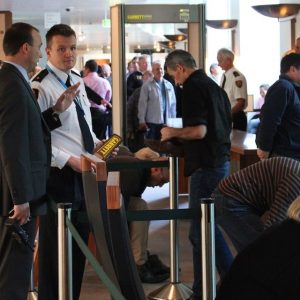
As the 100th anniversary of Anzac Day approaches, MPs are over-protecting themselves with new armed guards inside the Houses of Parliament. What message does that send citizens?
MPs fail Anzac bravery test
By Bill Rowlings, CEO of Civil Liberties Australia
Security “theatre” has become so over-the-top in Canberra that armed guards are now protecting MPs and senators inside the houses of parliament, watching secretly like shadowy spectres, presumably with trigger fingers poised, hidden behind glass in both chambers.
One question is: what would happen if the armed guards opened fire in the enclosed chambers? Would it be a Lindt Cafe siege all over again? How many MPs would die from police bullets, or parts of bullets?
The Speaker of the House of Representatives, solicitor Bronwyn Bishop from suburban Sydney in NSW, and Senate President, embalming mortician and policeman Stephen Parry from Launceston in Tasmania, have ordered the extra armed guards in the second tranche of ramped-up security for the parliament.
Guards with guns are now stationed in the House of Representatives and in the Senate, in glass-enclosed booths from which the parliamentary audio/video teams operate.
Just as the 100th anniversary of the bravery of Diggers at Anzac Cove is to celebrated, our MPs are apparently heading in the other direction: before getting to the chambers – now each protected by their own armed guards – people entering parliament have to get through:
- armed police officers outside Parliament House, and underneath in its bowels, and
- unarmed police and security guards patrolling outside parliament, always (24/7), and
- security screening machines, and guards, at every inlet, and
- protective services guards, with video monitors, in the main public entrance, and
- a second set of security screening machines, and guards, to get into question time, and
- security guards, with ID readers, to get from the public area to the Members-only area, and
- security guards stationed outside every Committee hearing room, and
- additional guards and police outside the ministerial office area, and
- even more guards and police outside and inside the Prime Minister’s office (within the above already guarded Ministerial area), and
- guards and attendants wandering the public and private corridors, constantly, and
- attendants stationed at key points near all lifts and main corridors inside both the public and private areas…
…as well as a massive video camera surveillance system so great it could easily identify who went in and out of Senator John Faulkner’s office when he was trying to conduct private whistleblower conversations. The video cameras have operators watching them full time when MPs are in the parliament.
The parliament building is of course also built under ground, which protects it from aerial bombing.
In communications theory, the Australian Parliament is classical one-way, asymmetric system: that is, they can send messages out, but you get a poor response if you want to turn the conversation in the other direction. Most responses to questions, critiques and suggestions to MPs involve pro forma responses.
The big question over the beefed-up security inside the houses of parliament is about the message it sends to all other Australian citizens: we’re MPs, we’re important, we’re looking after ourselves first, is what it says.

